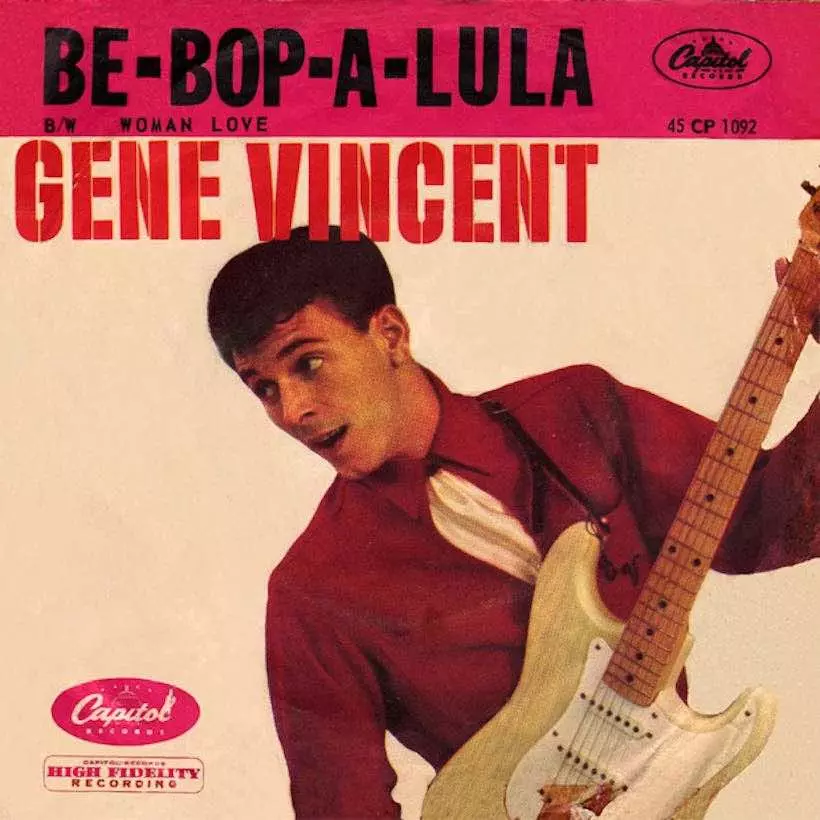 | Be-Bop-A-LulaGene Vincent & His Blue Caps |
Writer(s): Gene Vincent, Donald Graves Bill “Sheriff Tex” Davis (see lyrics here) First Charted: June 15, 1956 Peak: 7 US, 5 CB, 6 HR, 7 CW, 8 RB, 16 UK, 2 DF (Click for codes to charts.) Sales (in millions): 2.0 US Airplay/Streaming (in millions): 1.0 radio, 8.36 video, 31.75 streaming |
Awards:Click on award for more details. |
About the Song:Singer and guitarist Gene Vincent was born in 1935 in Norfolk, Virginia. He only had four Billboard Hot 100 entries, but was considered one of rock and roll’s pioneering artists and in the UK “became one of the biggest influences on everyone who sang or played a guitar.” AH He was inducted into the Rock and Roll Hall of Fame and the Rockabilly Hall of Fame. His biggest hit, “Be-Bop-A-Lula,” drew comparisons to Elvis Presley. It was Elvis, in fact, who inspired Vincent to pursue a music career. After seeing Elvis perform in September 1955, Vincent went to the radio station which had promoted the show and got an audience with DJ Bill “Sheriff Tex” Davis. Soon afterward, Vincent was the opening act for Carl Perkins when he came through town. Davis asked Perkins for his thoughts on the singer. Perkins though the boy had potential, particularly noting the song “Be-Bop-A-Lula.” AH Davis would become Vincent’s manager. Different stories have circulated about how the song originated. Supposedly Vincent wrote the music for the song while recuperating from a motorcycle accident at the US Naval Hospital in Portsmouth, Virginia. However, the words have also been credited to Donald Graves, who may or may not have met Vincent in the hospital and may or may not have sold the song to Vincent for $25. TB Davis claims he and Vincent wrote the song after listening to “Don’t Bring Lulu.” WK Vincent claimed the lyrics were inspired by the comic strip “Little Lulu.” WK The title is similar to the 1945 #3 hit “Be-Baba-Leba” for Helen Humes. Lionel Hampton re-recorded the song as “Hey! Ba-Ba-Re-Bop.” The phrase was widely used in the 1940s in jazz circles, lending its name to the bebop style. It supposedly was derived from the shout by Latin American bandleaders of “Arriba! Arriba!” WK Then there’s the melody. It’s nearly identical to the Drifers’ “Money Honey.” AH A demo of “Be-Bop-A-Lula” was given to Capitol Records, who wanted a young singer to rival Elvis Presley. Vincent had “the rebel image and swagger they were looking for” SF along with “Presley-like good looks” DM and “a sulky country-blues baritone that fit the new rock and roll songs.” DM Vincent would never attain that level of stardom. He was troubled and dark and a slave to painkillers because of his motorcycle accident. TC However, “Be-Bop-A-Lula” earned Vincent a place in rock history nonetheless. The record company invited Vincent to Nashville, Tennessee, where he recorded the song in Owen Bradley’s studio on May 4, 1956. WK It was released as the B-side to “Woman Love.” The BBC banned it and radio stations in the U.S. weren’t interested, but Capitol Records then made “Be-Bop-A-Lula” the A-side and it became a significant crossover hit reaching the top 10 on the pop, country, and R&B charts. It is “a gibberish song with no real lyrical content at all – but that doesn’t matter.” AH It “is probably the record which, more than any other, epitomizes 1956.” AH Resources:
First posted 10/23/2022; last updated 3/30/2023. |








No comments:
Post a Comment